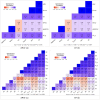Climate-smart rice (Oryza sativa L.) genotypes identification using stability analysis, multi-trait selection index, and genotype-environment interaction at different irrigation regimes with adaptation to universal warming
- PMID: 38879711
- PMCID: PMC11180187
- DOI: 10.1038/s41598-024-64808-9
Climate-smart rice (Oryza sativa L.) genotypes identification using stability analysis, multi-trait selection index, and genotype-environment interaction at different irrigation regimes with adaptation to universal warming
Abstract
Climate change has brought an alarming situation in the scarcity of fresh water for irrigation due to the present global water crisis, climate variability, drought, increasing demands of water from the industrial sectors, and contamination of water resources. Accurately evaluating the potential of future rice genotypes in large-scale, multi-environment experiments may be challenging. A key component of the accurate assessment is the examination of stability in growth contexts and genotype-environment interaction. Using a split-plot design with three replications, the study was carried out in nine locations with five genotypes under continuous flooding (CF) and alternate wet and dry (AWD) conditions. Utilizing the web-based warehouse inventory search tool (WIST), the water status was determined. To evaluate yield performance for stability and adaptability, AMMI and GGE biplots were used. The genotypes clearly reacted inversely to the various environments, and substantial interactions were identified. Out of all the environments, G3 (BRRI dhan29) had the greatest grain production, whereas G2 (Binadhan-8) had the lowest. The range between the greatest and lowest mean values of rice grain output (4.95 to 4.62 t ha-1) was consistent across five distinct rice genotypes. The genotype means varied from 5.03 to 4.73 t ha-1 depending on the environment. In AWD, all genotypes out performed in the CF system. With just a little interaction effect, the score was almost zero for several genotypes (E1, E2, E6, and E7 for the AWD technique, and E5, E6, E8, and E9 for the CF method) because they performed better in particular settings. The GGE biplot provided more evidence in support of the AMMI study results. The study's findings made it clear that the AMMI model provides a substantial amount of information when evaluating varietal performance across many environments. Out of the five accessions that were analyzed, one was found to be top-ranking by the multi-trait genotype ideotype distance index, meaning that it may be investigated for validation stability measures. The study's findings provide helpful information on the variety selection for the settings in which BRRI dhan47 and BRRI dhan29, respectively, performed effectively in AWD and CF systems. Plant breeders might use this knowledge to choose newer kinds and to design breeding initiatives. In conclusion, intermittent irrigation could be an effective adaptation technique for simultaneously saving water and mitigating GHG while maintaining high rice grain yields in rice cultivation systems.
Keywords: AMMI; GGE biplot model; MGIDI; Rice; Yield; web-based WIST.
© 2024. The Author(s).
Conflict of interest statement
The authors declare no competing interests.
Figures













Similar articles
-
Country-wide, multi-location trials of Green Super Rice lines for yield performance and stability analysis using genetic and stability parameters.Sci Rep. 2024 Apr 24;14(1):9416. doi: 10.1038/s41598-024-55510-x. Sci Rep. 2024. PMID: 38658570 Free PMC article.
-
Genotype-by-environment interaction and stability analysis of grain yield of bread wheat (Triticum aestivum L.) genotypes using AMMI and GGE biplot analyses.Heliyon. 2024 Jun 14;10(12):e32918. doi: 10.1016/j.heliyon.2024.e32918. eCollection 2024 Jun 30. Heliyon. 2024. PMID: 38988541 Free PMC article.
-
Evaluation of genotype by environment interaction and adaptability in lowland irrigated rice hybrids for grain yield under high temperature.Sci Rep. 2021 Aug 4;11(1):15825. doi: 10.1038/s41598-021-95264-4. Sci Rep. 2021. PMID: 34349182 Free PMC article.
-
Assessing yield performance and stability of local sorghum genotypes: A methodological framework combining multi-environment trials and participatory multi-trait evaluation.Heliyon. 2024 Feb 7;10(4):e25114. doi: 10.1016/j.heliyon.2024.e25114. eCollection 2024 Feb 29. Heliyon. 2024. PMID: 38370242 Free PMC article. Review.
-
A multi-level approach reveals key physiological and molecular traits in the response of two rice genotypes subjected to water deficit at the reproductive stage.Plant Environ Interact. 2023 Sep 15;4(5):229-257. doi: 10.1002/pei3.10121. eCollection 2023 Oct. Plant Environ Interact. 2023. PMID: 37822730 Free PMC article. Review.
Cited by
-
Manure-biochar compost mitigates the soil salinity stress in tomato plants by modulating the osmoregulatory mechanism, photosynthetic pigments, and ionic homeostasis.Sci Rep. 2024 Sep 20;14(1):21929. doi: 10.1038/s41598-024-73093-5. Sci Rep. 2024. PMID: 39304737 Free PMC article.
-
A comprehensive multivariate approach for GxE interaction analysis in early maturing rice varieties.Front Plant Sci. 2024 Oct 1;15:1462981. doi: 10.3389/fpls.2024.1462981. eCollection 2024. Front Plant Sci. 2024. PMID: 39411651 Free PMC article.
-
Phenotypic diversity in qualitative and quantitative traits for selection of high yield potential field pea genotypes.Sci Rep. 2024 Aug 9;14(1):18561. doi: 10.1038/s41598-024-69448-7. Sci Rep. 2024. PMID: 39122809 Free PMC article.
-
Comparative analysis of stability models for identifying rice inter-subspecific breeding lines adapted to different temperature regimes for exploitation in hybrid breeding.BMC Plant Biol. 2025 Apr 30;25(1):563. doi: 10.1186/s12870-025-06484-z. BMC Plant Biol. 2025. PMID: 40301720 Free PMC article.
-
Multi-Trait Index-Based Selection of Drought Tolerant Wheat: Physiological and Biochemical Profiling.Plants (Basel). 2024 Dec 26;14(1):35. doi: 10.3390/plants14010035. Plants (Basel). 2024. PMID: 39795295 Free PMC article.
References
-
- Abdelrahman M, Alharbi K, El-Denary ME, Abd El-Megeed T, Naeem ES, Monir S, Al-Shaye NA, Ammar MH, Attia K, Dora SA, Draz ASE. Detection of superior rice genotypes and yield stability under different nitrogen levels using ammi model and stability statistics. Plants. 2022;11(20):2775. doi: 10.3390/plants112. - DOI - PMC - PubMed
-
- Rabbany MG, Mehmood Y, Hoque F, Sarkar T, Hossain KZ, Khan AA, Hossain MS, Roy R, Luo J. Do credit constraints affect the technical efficiency of Boro rice growers? Evidence from the district Pabna in Bangladesh. Environ. Sci. Pollut. Res. 2022;29:444–456. doi: 10.1007/s11356-021-15458-1. - DOI - PubMed
-
- Shelley IJ, Takahashi-Nosaka M, Kano-Nakata M, Haque MS, Inukai Y. Rice cultivation in Bangladesh: Present scenario, problems, and prospects. J. Int. Crop Agric. Dev. 2016;14:20–29. doi: 10.50907/jicad.14.0_20. - DOI
MeSH terms
LinkOut - more resources
Full Text Sources
Medical
Research Materials

